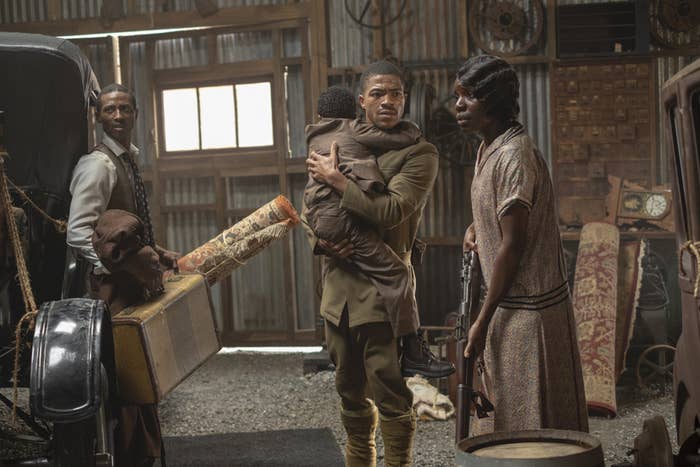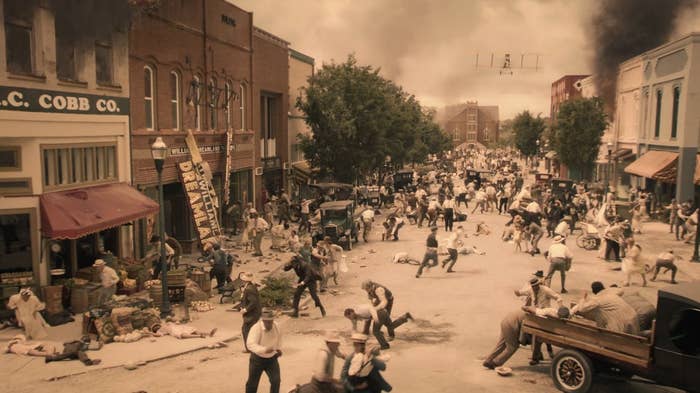
Ed. note: This post includes spoilers for HBO’s Watchmen.
The premiere of HBO’s Watchmen was watched by more than 1.5 million viewers on its first night across television and streaming services, the strongest debut performance for the network.
To be frank, it should’ve been more.
In a real-world where white nationalism makes the news in one form or another, the Watchmen pilot grappled with racism and police brutality in a way that most Americans had never experienced before. Opening upon the Tulsa Massacre of 1921, an event that, sadly, trended on socials for all of the wrong reasons—white Tulsa residents decimated and terrorized a part of town known as “Black Wall Street”.
Hundreds of Black men, women, and children were engulfed by fire, shot down by a hail of bullets, and were obliterated by firebombs dropped from passing biplanes. The two-day bloody attack only survived through the oral history of its survivors and is considered “the single worst incident of racial violence in American history,” according to the Oklahoma Historical Society. Directed by Nicole Kassell (The Killing, Claws)—“It’s Summer and We’re Running Out of Ice” is shot like war footage from Time. Lynch mobs are looting and shooting people right in the street, while babies are being orphaned and an entire town’s legacy is being wiped off the face of the map.
“When I read the script, I did not know about the event,” Nicole told Complex in a phone interview. “I did not know it was true history.” The 47-year-old director had worked with Watchmen show creator Damon Lindeloff before on The Leftovers and when she got the call for his new TV series, Lindelof looked to her as a trusted voice to keep the WTFs going. “We did a five-day scout to find where production should live [with the first episode] and in order to know what I would be replicating, I wanted to go to Tulsa and specifically Greenwood." Between May 31 and June 1, 1921, the Tulsa massacre started after a 19-year-old Black male was accused of assaulting a 17-year-old white girl. We’ve read and witnessed this story play out before, where whites were incensed by the allegations, and then they took the rest into their own hands. Nicole, originally from Charlottesville, Virginia, was shaken to the core by the white supremacist protests in 2017. As a filmmaker, she didn’t know how to respond, but thankfully Watchmen provided an outlet to make a statement. “I did an incredibly deep dive on research and went to the Greenwood Cultural Center,” she shared. “I stood where the Dreamland Theater was, which now has been turned into an overpass of a highway going through there.”
As Kassell and the team got closer to production, Nicole asked Damon to write a letter to the cast and crew to tell the true story as told in Tim Madigan’s The Burning. “[We] wanted to honor what we were going to ask everyone to go through in re-staging this [event] because it was so horrifying and harrowing, and I wanted to be extremely sensitive to what we were asking people to do again, behind the camera and in front of.” Production fell in line and was very supportive, which was important to capture the realism that unfolded in Tulsa ‘21. Thirty of the background actors run rehearsals in a back studio lot in Macon, Georgia, which was turned into Tulsa for the show. “They [background actors] did rehearsals and then presented it to me. I witnessed it, gave feedback, and we were able to turn those actors that came in for rehearsal into a point person for their vignette. If anyone felt anything, if anybody needed anything, then they had a direct connection to the assistant directing team.”

Filming, which took two days, fell upon the 97th anniversary of the event. Feeling the ghosts of the past, Nicole helped to aid in the healing process before production began by having a priest come in to bless the set. “That was done with the entire cast and crew together to honor the fallen and just to set the tone. Because we were starting in this way [with Tulsa ‘21], it was really important to me that we have that additional support.” With violence happening all over the place, one of the most claustrophobic scenes was when the young boy (played by Danny Boyd Jr.) was in the trunk as the car attempted to escape the calamity. “We were actually able to do [the scene] on stage and used little plugs in the wood to serve as the shots ripping through the trunk,” Nicole said. “I would holler or clap some wood together and that’s what Danny would respond to with the special effects team yanking these plugs out.”
“It’s Summer and We’re Running Out of Ice” was cathartic for Nicole, as she said it was a “personal relief” that she could put her pent-up energy from the Charlottesville incident into something “very concrete and important.” “My father is Jewish and I am half-Jewish. We all lived in Charlottesville, and I’m just realizing in talking with you, that my ancestors escaped the pogroms of Ukraine. How much is there actually in my DNA history that I’m not even aware of that I am pouring into this?” she asked rhetorically. Outside of reading how Ava DuVernay had her set blessed for the bridge scene in Selma and the ways Steven Spielberg went about constructing Auschwitz for Schindler’s List, Nicole didn’t study any other battle scenes when it came time to film the Watchmen pilot. “I really took it [all] from the book,” she said. “Because it is mostly oral history where things are described, there are moments that were seared onto my brain.”
From seeing a white man wearing a Black mother’s prized leper fur coat to somebody playing the piano while all these atrocities are happening, Nicole used a still image that someone in production had found for the portion where there was a little boy holding a dead baby in the street. “There’s many little vignettes that we staged that weren’t put into the show because it was just too much,” Nicole mentioned. “I really did just focus in on what are these true events that I’ve read and how to get them onto screen.” Recreating Tulsa, Oklahoma in Macon, Georgia was an interesting development where the crew broke the street into five sections and each would be staged one section at a time. “We had a hero camera plus three other cameras just picking up the surrounding events, so we didn’t have to do too many takes.”
Despite the reverential atmosphere, there were a few moments of brevity throughout. “At least one person on our set had a relative who had survived Tulsa ‘21,” Nicole said. “I have an incredible still of a group of actors in between takes sitting on a bench [just] laughing so hard. It was a gift to me to show that in between such horror, people were having a great time. That was really important to me that there was that the combination of a safe environment and support to where people could relax, kick back, and joke around.”
At the end of it all, Watchmen serves as the first major dramatization of an event that was not properly recognized by American history for nearly a century. In a real-world where white nationalism threatens us all, Nicole’s awareness of what bringing this story to the screen means to people who feel underrepresented in mainstream media. With pop culture taking the reigns of showcasing the brutal history, “It’s Summer and We’re Running Out of Ice,” hopefully marks the beginning of more television shows expressing truth to power to change the racist climate and create a real shift across the board.

